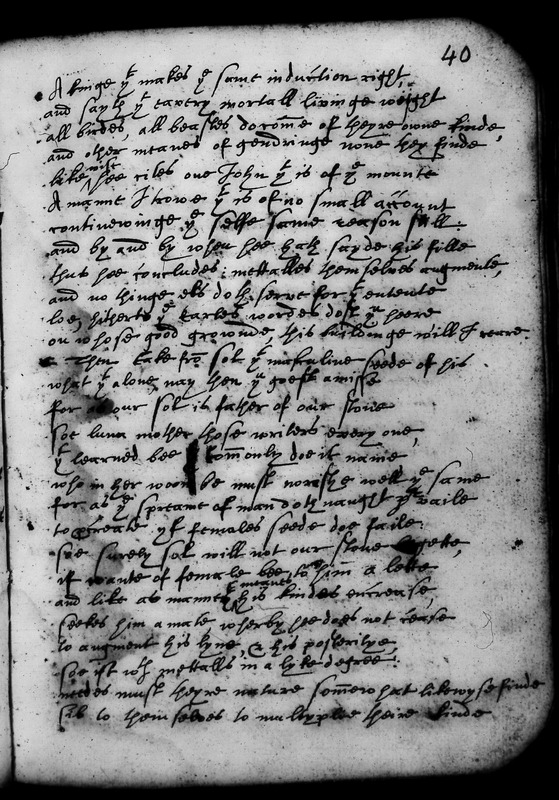Alchemical Metaphors and Practices
Metaphors Galore
Gendered and biological metaphors occur frequently in alchemical poems. At first glance, they may appear confusing to twenty-first-century readers, especially compared to dry modern scientific texts. However, they were acceptable and useful for early modern alchemists.
Since there were no obvious distinctions between literature and science writings, it makes sense that alchemists would express their ideas in metaphorical terms, including gender. This would have been a familiar metaphorical language to alchemists and their readers, making their alchemical ideas more familiar. Thus, their ideas were transmissible through this language of gender.
Additionally, gendered personification gives insight into the alchemists’ worldview. They personified knowledge, reason, and nature as women. Alchemists would often speak to these women, seeking to gain a greater understanding of alchemical secrets. Although this was likely done because of the classical imagery of these concepts as women, it is still an interesting dynamic, especially given almost no records of women practicing alchemy exist. However, alchemists also associated certain metals, namely silver and gold, with male and female attributes. This points to their belief that everything in the universe was balanced, and gender was one way to express this balance of the elements. Hence, gender was another way for them to express their theoretical ideas without stating them directly.
In a similar vein, conception and pregnancy are frequent metaphors in alchemical texts. For example, the central vessels in which alchemists performed their experiments to create the Philosopher’s Stone were compared to wombs. Additionally, mercury and silver were described as coming together to create other elements, like the sperm and egg coming together at conception. Alchemists related their procedures to gendered biological processes to convey their information more effectively. They are also representations of the interconnectedness of early modern scientific disciplines. Furthermore, the conversations between a female personified figure and a male alchemist are macro versions of these conception metaphors, where two balanced elements come together to create something new.
Gender and pregnancy-related language are common tropes in alchemical poetry. It was used to explain their processes more viscerally and to connect them to their broader place in science.
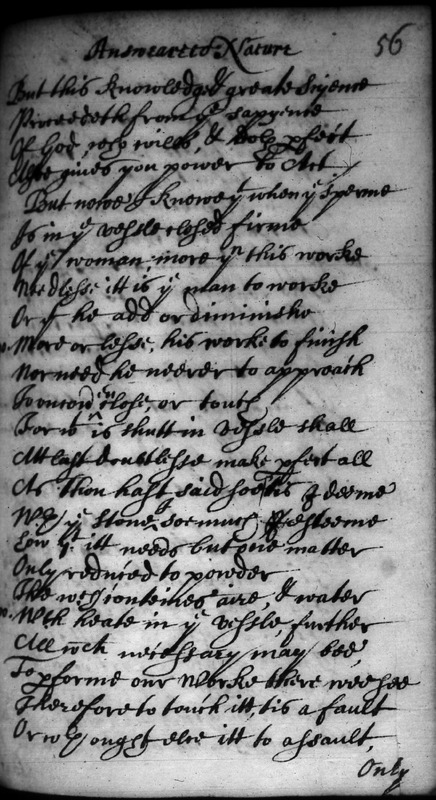
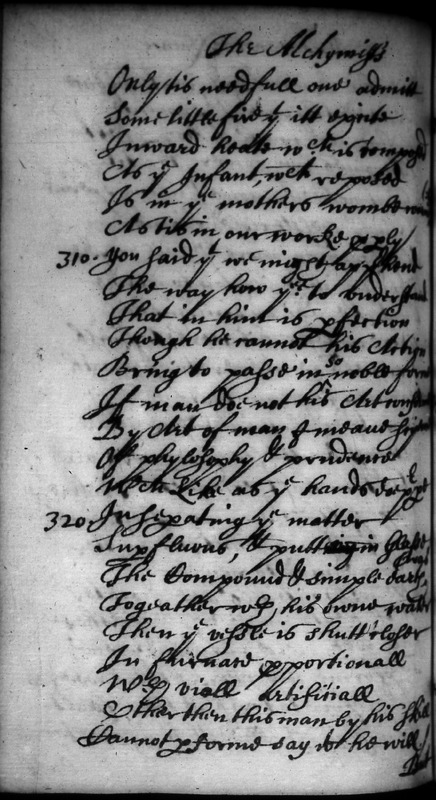
A Science of Secrets
Although these metaphors were understood by those in the alchemical community, they were also meant to obscure their research. Indeed, an element of secrecy dominates a lot of alchemical writing and, as a result, was often pushed to the side by mainstream thinkers.
In these poems, alchemists describe their processes, but often indirectly. They might tell a reader to place a specific metal in a vessel over a fire, but they never specify how long to leave it over the flames. Or they might instruct a reader to combine two metals, but they don’t specify the ratio of the two metals or how to combine them. Many texts claim to provide a recipe for the Philosopher’s Stone and there are some recognizable chemical experiments, but metaphors obscure most recipes and make them unintelligible to an outsider. Although some of these details might have been left to the practitioner’s decision because of imprecise measurement tools, there are sufficient omissions to suggest the alchemists were deliberately vague. The question remains, however, why did they do this?
Generally, alchemists were trying to protect what they viewed as sacred knowledge from falling into the wrong hands. They believed it was truly possible to turn lead into gold, and this valuable skill should be kept by those educated enough to understand the correct use of the process. Additionally, the Philosopher’s Stone was said to perform magical transformations and purifications, which alchemists would also want to control. Some reasons for these desires can be traced to practical concerns, but a large part was likely motivated by a sense of spiritual duty to protect the gift God had given them. It was sacred knowledge He had given them, which was not meant to be shared with just anyone. .
Hence, there was a fundamental tension in alchemy between making it understood by those meant to have such sacred knowledge and making it unintelligible by those who were not. This likely drove them to use metaphors and other literary techniques in their writings.
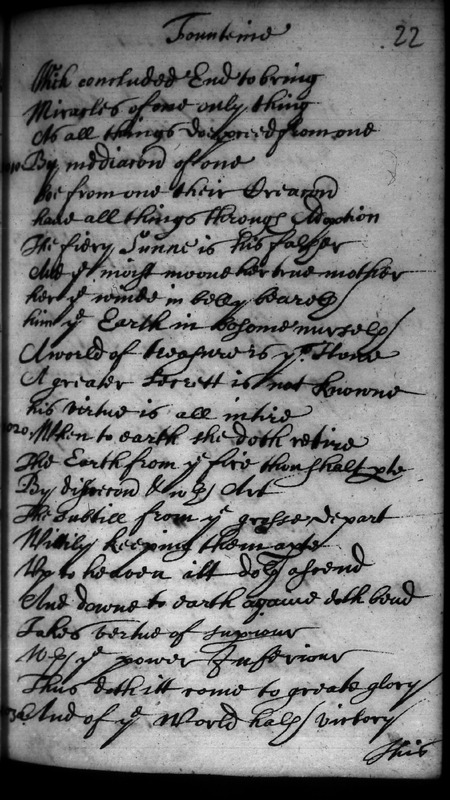
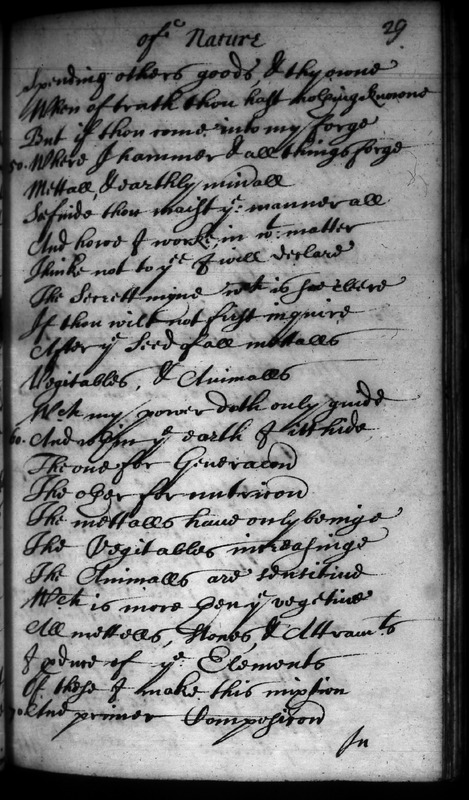
Public vs Private
Because of the tendency to secrecy, it is clear there was tension between the private and public aspects of alchemy.
Looking at the original texts, the handwriting is rather messy and cramped. One manuscript is a personal notebook for Elias Ashmole and contains poems translated by his mentor. Although Ashmole published a collection of alchemical texts, none of the works are printed in this collection. This notebook was written by Ashmole himself, suggesting that it was a private practice for Ashmole and his mentor William Backhouse.
However, there was a public aspect to alchemy. Alchemists were trying to gain access to patronage and, to a certain extent, spread their knowledge to others. Additionally, these texts were copied repeatedly throughout the centuries. For example, the poems copied by Ashmole were translations of the medieval texts, and this specific manuscript of Ali Puli’s treatise was copied during the nineteenth century, even though it was first published in the 1680s. Hence, alchemical knowledge was public enough that someone was able to preserve it, and some continued to take an interest in it.
Despite the prevailing interest, there was still tension within alchemy, as alchemists wanted to preserve their knowledge for future generations to continue seeking the Stone, but they also wanted to keep it secret from most people.
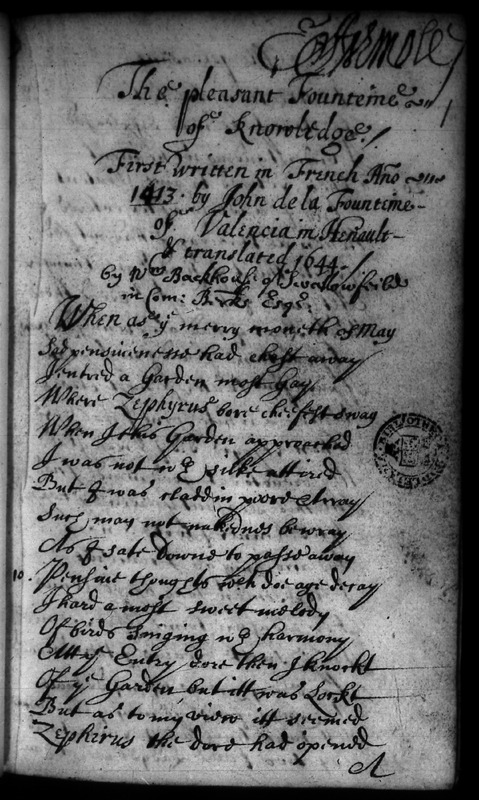
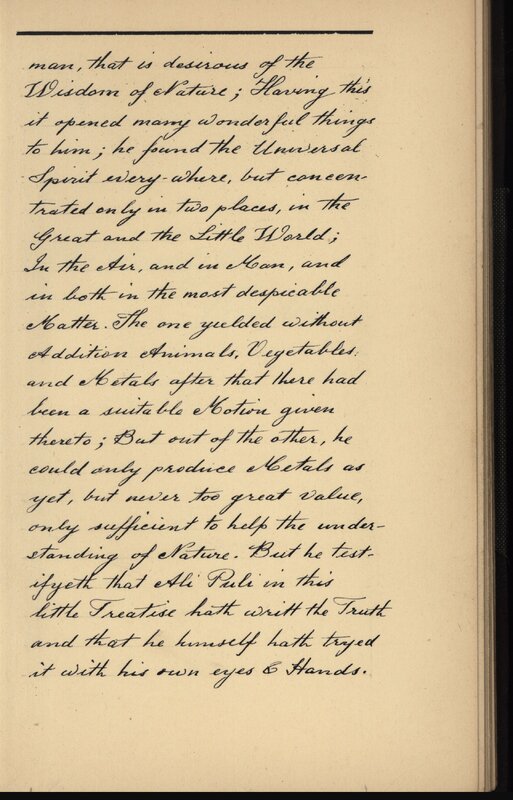
This handwriting is definitively nineteenth-century cursive, indicating that was when this particular manuscript was copied.
Alchemical Relationships
Alchemists were not an organized or uniform group, but there were links binding alchemists together.
Some level of organization was necessary to teach the next generation of alchemists because alchemy was not taught in universities. So, alchemists created a variety of methods to transmit their knowledge to new members or share their pursuits with others. For example, in seventeenth-century England, a group of men formed a mystical fraternity with strong connections to alchemy, and they likely practiced together. Additionally, they would induct new members who had to be sponsored by a ‘father’ to gain entry and learn their secrets. This language of father-son relationships between alchemists is like a mentor-pupil relationship and shows up frequently. Elias Ashmole, who mostly collected alchemical texts, was adopted as an alchemical son by William Backhouse, who translated medieval French poems into English. Backhouse heavily influenced Ashmole, who even copied some of Backhouse’s translations in his personal notebooks. These relationships were a common and influential way for alchemists to maintain knowledge and keep the field going.
But who were these men that practiced alchemy? More often than not, they were men like Elias Ashmole. Ashmole was between the middle-class and the aristocracy, which gave him the funds necessary to pursue his experiments. Although he wasn’t university educated, Ashmole was sufficiently well off to give himself the free time to study or pursue his various interests. However, Ashmole’s other interests included gardening and Baconian science, which reflect alchemists’ scientific bents. Most alchemists were wealthy aristocrats or university faculty who pursued alchemy as a hobby; it was rare for an alchemist to make his living that way.
Although alchemy was a science of secrets, there were ways for people to keep knowledge alive. However, it was largely restricted to wealthy men who had the free time to pursue alchemical studies as a hobby.
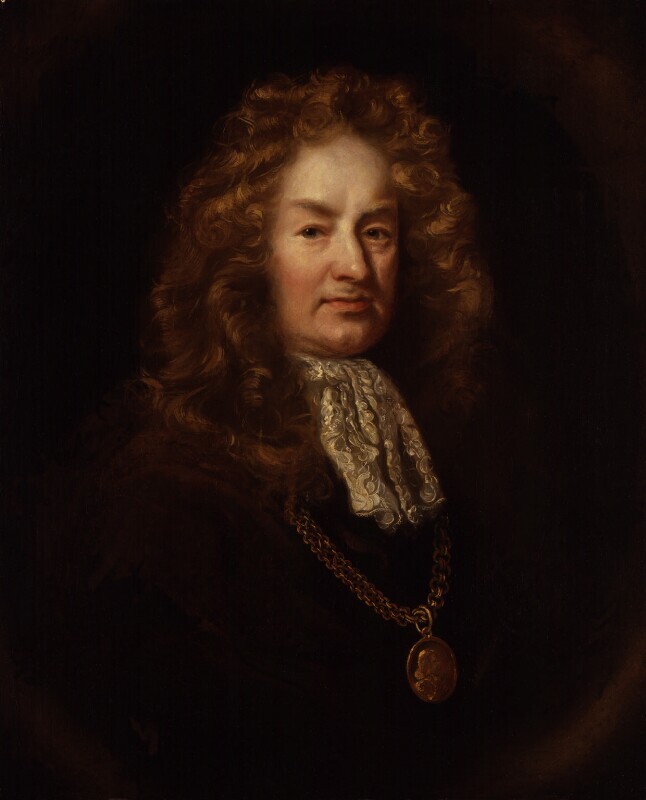
Elias Ashmole
after John Riley
oil on canvas, feigned oval, based on a work of 1687-1689
NPG 1602
© National Portrait Gallery, London
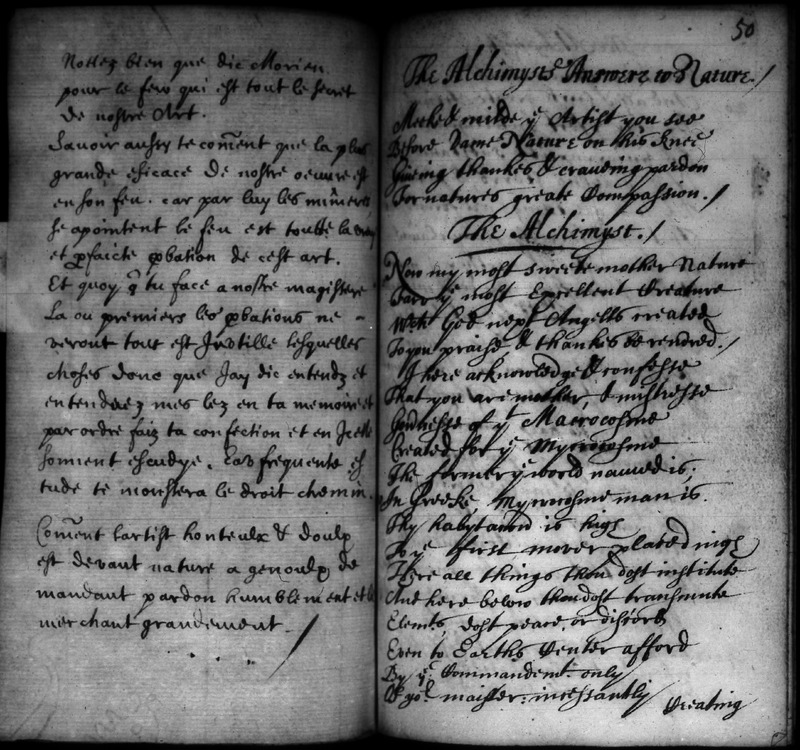
An Enduring Appeal
Despite all the secrecy and alchemy’s marginal status, it continued to fascinate people through the centuries, arguably even today. Writers in the early modern period would return to the old texts, again and again, translating, compiling and editing them as they saw fit. They may have also recreated experiments. Some alchemists collaborated across various locations and there was a significant cultural exchange between French, English, and German alchemists, as well as those further afield. For example, Arabic alchemists and chemists strongly influenced European thinkers. It is believed they introduced alchemy to the West. They were held in such high esteem that Johann von Helwig attributed his work to Ali Puli, who was sometimes described as an Arabian, and claimed the treatise was originally written in Arabic. In modern times, alchemists are used in literature as spiritual-psychological metaphors or magical backdrops in fantasy novels. Although no one is trying to replicate the experiments, it still has an enduring appeal to us today and its use as a literary device is oddly fitting for a genre that loved metaphors and poetic writing.
Although alchemy continues to have a presence in popular culture, it carries an element of mystery that sometimes equates to magic. But these men who practiced alchemy weren’t magicians, nor were they purely spiritualists. More often than not, alchemists were seeking to understand the world around them and how it functioned within their worldview. They were often deeply connected to religion, but this is true of everyone in medieval and early modern Europe. Alchemists were following the very human desires to understand and exert some control over the world. Ironically, scientists have turned lead into gold using a particle accelerator. However, it is costly and requires a vast amount of energy, making it impractical on a vast scale, much like how alchemists would have wanted it. But it is not hard to imagine that alchemists would be thrilled to finally see one of their dreams come to life.
Home Page 🔥 A Brief Introduction 🔥 The Motivations of Alchemists
Alchemical Metaphors and Practices 🔥 About 🔥 Index
